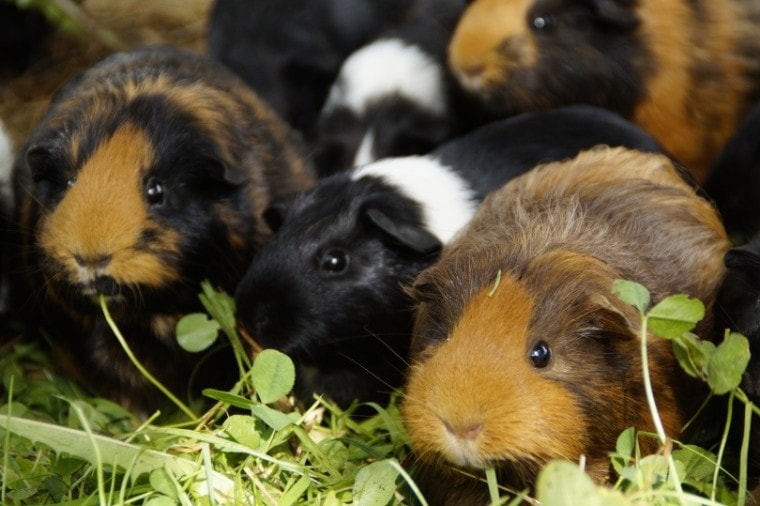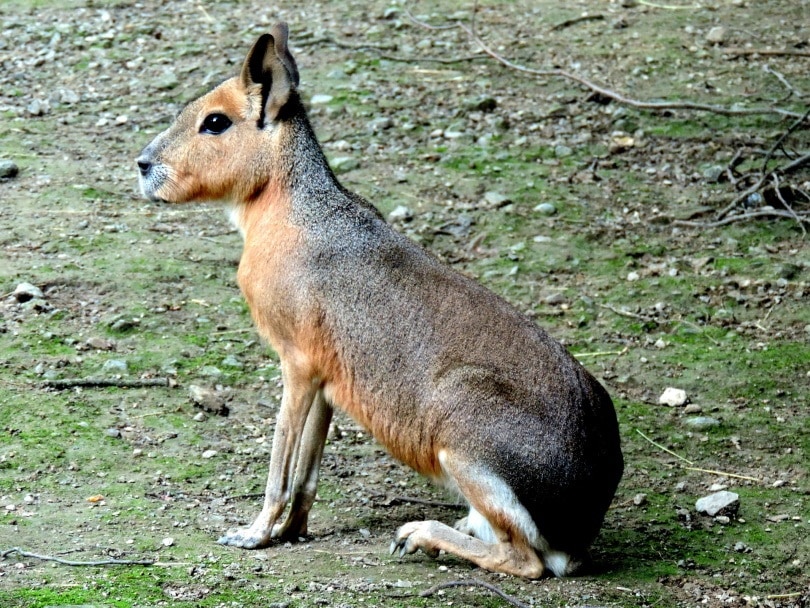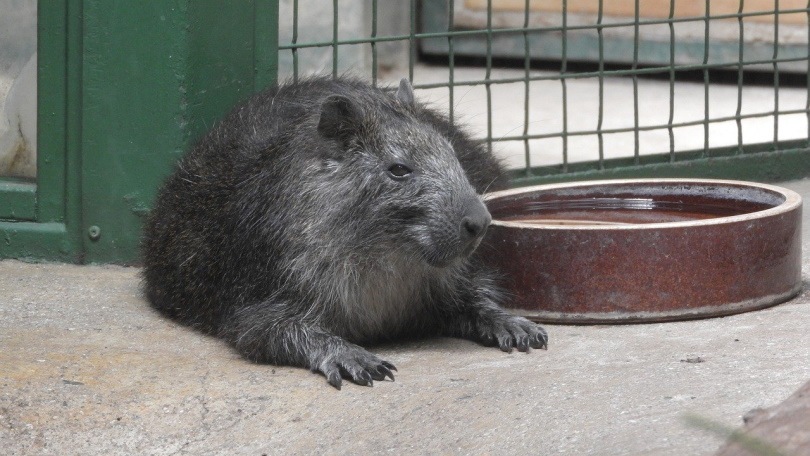What Animal Looks Like A Giant Rat

What practise you first think of when you hear the word "rodent"? Does your mind produce images of beautiful, cuddly little mice and hamsters? Or do you picture a sewer rat swimming through murky atmospheric condition and spreading illness?
I of these two scenarios is what most people imagine. And due to the latter, many people take an extreme aversion to rodents in general. Just these two situations aren't the only place that rodents exist.
In fact, rodents are amid some of the most versatile animals on the planet. Rodents really brand up the largest unmarried group of mammals in the animal kingdom. And believe it or not, nearly non-flying mammals are rodents—making up approximately ane/iii of all mammalian species! They're institute natively on every continent in the world (except Antarctica) and come in all shapes and sizes.

But which rodents are the biggest? We'll explore some of the largest living rodents in the world today—forth with a couple of their ancestors—so you tin truly see the latitude of their existence.
The Top ten Largest Rodents in the World
i. Capybara

| Scientific Proper name: | Hydrochoerus hydrochaeris |
| Where It'southward Institute: | The Capybara is a native to South America—particularly in Brazil, Colombia, Venezuela, Argentine republic, and Peru. |
| Length: | This rodent tin can grow up to four.iv feet in length and can reach upward to 24 inches tall. |
| Weight: | Capybara can weigh anywhere between 77 to 146 pounds. |
The capybara is currently considered the largest living rodent in the world. This rodent is usually found in semi-aquatic areas and is an excellent swimmer. Their nutrition consists of grass, fruit, and other aquatic vegetation. And they've been known to exist a nuisance to indigenous peoples' gardens and farms.
In many South American countries, capybara meat is considered a delicacy. Information technology's go a particularly popular exotic dish in Venezuela served during Easter celebrations.
2. Coypu (Nutria)
| Scientific Name: | Myocastor coypus |
| Where It's Found: | The coypu is a rodent that tin can be found in countries with subtropical climates on the continents of North America, Due south America, Asia, Africa, and Europe. |
| Length: | Coypu can abound ii.three to iii.five feet. |
| Weight: | Information technology can weigh up to 37 pounds. |
The coypu is a semi-aquatic, herbivorous, couch-dwelling house rodent. It is thought to be native to South America, however, it can also be found in North America, Asia, and Europe. They are believed to have spread throughout the globe past stowing themselves away in exploration ships.
They resemble giant rats and can infest rural farm areas. Back in the 1940s, the coypu became a major nuisance to farm owners in England and the United States—particularly in Maryland and Louisiana. By the 1960s, legislation was created to eradicate the subversive coypu rodents.
However, coypu rodents are at present existence put to adept use. Nutria fur is used by many fashion designers including major houses such every bit Oscar de la Renta and Michael Kors. Nutria meat can likewise be found labeled as ragondin in many domestic dog treats and kibble as a source of lean protein.
three. Muskrat
| Scientific Proper name: | Ondatra zibethicus |
| Where It'due south Found: | The muskrat can exist found in North America, South America, Asia, and Europe. |
| Length: | A fully grown muskrat tin can grow 1.3 to 2.3 feet in length. |
| Weight: | It can weigh around 1 to 4.4 pounds |
The muskrat is a semi-aquatic rodent that is considered "medium-sized", although it can grow quite large in its adult life. These rodents offering a very important contribution to their ecosystems, providing a stable source of nutrient for natural predators such every bit minks, eagles, and otters. They're also a staple of fur and food for people.
The Native Americans accept e'er considered muskrats an important part of their life. Some groups believe that muskrats can predict the level of snow in the wintertime by looking at the rodent's size and timing of their guild construction.
4. Patagonian mara

| Scientific Proper name: | Dolichotis patagonum |
| Where It's Found: | Patagonian maras are mostly found in Patagonia and Argentine republic. |
| Length: | A Patagonian mara grows about 2.iii to 2.5 feet from its head to its body. Their tails grow to effectually iv-5 cm long. |
| Weight: | A fully grown Patagonian mara can weigh between xviii to 35 pounds. |
The Patagonian mara is another very large type of rodent. Information technology's too known as the "Patagonian cavy", the "dillaby", and the "Patagonian hare" (mainly because information technology somewhat looks similar a rabbit). They are herbivorous rodents and are mostly constitute in open up habitat regions of Patagonia and Argentina.
Patagonian maras are very interesting rodents because of their unique social organization. They have a monogamous and communal fashion of breeding. Monogamous pairs will stay together for life. Breeding pairs of Patagonian maras can exist alone but are more commonly constitute within warrens. Each warren can exist shared by upwards to 30 pairs of Patagonian mara mates. In a single year, wild female person Patagonian maras produce only 1 litter. However, farmed maras can produce up to four litters.
Recently, Patagonian maras have been considered a threatened species. They have been affected by habitat alteration and hunting. A growing number of poachers hunt down and catch Patagonian mara for their skins as they are used to make rugs and bedspreads. Due to this, they have been mostly eradicated in the province of Buenos Aires.
5. Cape Porcupine
| Scientific Proper noun: | Hystrix africaeaustralis |
| Where It's Found: | Greatcoat porcupines are constitute in Africa—primarily in the countries of Kenya, Congo, and Uganda. |
| Length: | The trunk tin can grow from 2.1 to two.vii feet, while its tail can grow around 4 to 8 inches long. |
| Weight: | Male cape porcupines can counterbalance up to 37 pounds, and females upwardly to 41 pounds. |
The Greatcoat porcupine is currently the largest living rodent species constitute in Africa. Not merely that, simply information technology is besides the largest porcupine in the earth. They are plant in a broad range of habitats, from dry out deserts to dense forests. In savannah terrains, these rodents are known to create chambers in grassy areas to make birthing dens.
The cape porcupine can abound its spines to effectually 20 inches long and use them every bit an immensely powerful defense force mechanism. Fortunately for birthing mothers, when cape porcupines are born, their spikes are really very soft and harden as they are exposed to air.
Cape porcupines usually live approximately 15 years in the wild—which is unusually long for rodents. They usually feed on by and large institute materials such as roots, fruits, tubers, bark, and bulbs.
6. South African springhare
| Scientific Name: | Pedetes capensis |
| Where It'south Found: | This rodent is native to South Africa. |
| Length: | The South African springhare grows roughly 1.ane to one.5 feet. The tail can grow from one.2 to 1.5 feet long. |
| Weight: | An developed South African hare can weigh up to 6.6 pounds. |
The South African springhare is not a hare as its name implies, but is instead a large and peculiar rodent. It received its proper noun because of its ability to leap over six feet in just a single bound. It even looks like a strange kangaroo-rodent hybrid.
S African springhares are known to be nocturnal but have been seen being active during the daytime. Notwithstanding, they commonly stay within tunnels that they dig themselves when the sun is out. You'll notice them building their tunnels during the rainy season when the soil is wet and easy to dig. Only when night falls, these strange creatures will sally from their tunneled homes on the hunt for food.
vii. Bosavi Woolly Rats
| Scientific Name: | Yet to be published. |
| Where Information technology's Institute: | The Bosavi woolly rat has recently been discovered in Papua New Guinea. |
| Length: | This rodent can grow up to 32 inches in length. |
| Weight: | Bosavi woolly rats can weigh to up 13 pounds. |
The Bosavi wooly rat is one of the most recently discovered rodent species. The first come across was in 2009 when a team of researchers found the rat within the Bosavi Crater in Papua New Guinea. This is besides believed to have been the outset encounter these rats have ever had with humans.
When the offset Bosavi woolly rat was found, it measured 32 inches long, making it one of the largest existing rodents in the world. And it's currently the world'south largest living rat species.
More than exploration and studies are now existence done to find out more about this newly found rodent.
eight. North American Beaver
| Scientific Name: | Castor canadensis |
| Where It's Institute: | North American beavers are native to North America, merely other like species can too be found in South America and Europe. |
| Length: | They can abound up to iii feet long. Their tail can abound up to fourteen inches long. |
| Weight: | This rodent can counterbalance effectually 24 to 71 pounds. |
The North American beaver has an impressive long body which makes it one of the largest rodents in the world. And its long, apartment tail also enables it to swim through the water with ease. This helps the Native American beaver navigate rivers and other bodies of water where it usually spends most of its fourth dimension.
One of the well-nigh impressive skills of the North American beaver is controlling its environment by building dams. Their sturdy front teeth piece of work similar chisels in carving logs which are afterward used to block rivers. After creating these dams, these beavers then construct semi-flooded structures known as lodges in which they live and house their young.
9. Josephoartigasia
| Scientific Proper name: | Josephoartigasia monesi |
| Where It'southward Found: | Uruguay |
| Length: | The Josephoartigasia reached roughly x feet long. |
| Weight: | It is believed that Josephoartigasia weighed more than 2,000 lbs. |
Now extinct, the Josephoartigasia is considered to be the largest rodent to ever exist. Its fossils were found in Uruguay in 2007 when a skull was discovered. Researchers said that Josephoartigasia lived in a wet environs and fed on grasses and other ingather vegetation.
This rodent is believed to accept gone extinct after the Great American Interchange when animals from the continents of North and South America became able to brood with one another in the Mid-Cenozoic Era during the Neogene Catamenia. And there are only theories as to why their extinction happened.
Many researchers believe climate change to be the major factor that caused their disappearance.
x. Giant Hutia

| Scientific Name: | Heptaxodontidae |
| Where Information technology's Found: | Fossils of Giant Hutia have been found in the Westward Indies. |
| Length: | Unknown |
| Weight: | Estimated to have weighed between 110 lbs and 440 lbs |
The giant hutia — officially named Ambyrhiza — was a native rodent of the West Indies. They are believed to have lived more than 100,000 years ago in the Caribbean. Based on their skull size, they are considered to be 1 of the largest rodents to e'er exist.
Fossils discovered of the giant hutia can be larger than the size of a fully grown human. Because of its extremely large size, it is believed that the giant hutia moved slowly and was gratuitous of predators. And according to fossil records, there are no known competing mammals that lived during its existence.
At that place are smaller direct descendants of the behemothic hutia establish on the Caribbean area islands today, but they only weigh around 5 pounds.

Are There Other Giant Rodents?
Although at that place probably aren't any auto-sized rodents left in the world today, that doesn't mean other giant rodents aren't out there lurking. Remember, the Bosavi wooly rat was just recently discovered.
We'll only have to proceed our eyes peeled for any other rodents of larger stature in the years to come.

Featured Paradigm Credit: Hippopx
Source: https://petkeen.com/largest-rodents-in-world/
Posted by: culbertsoncrin1958.blogspot.com

0 Response to "What Animal Looks Like A Giant Rat"
Post a Comment